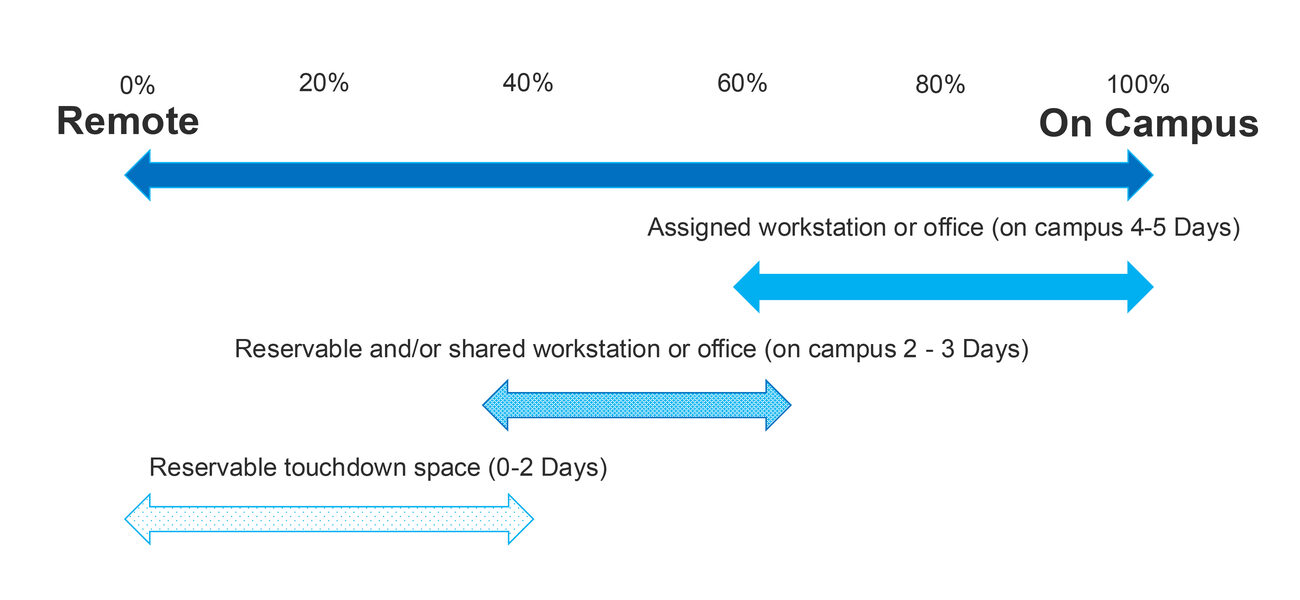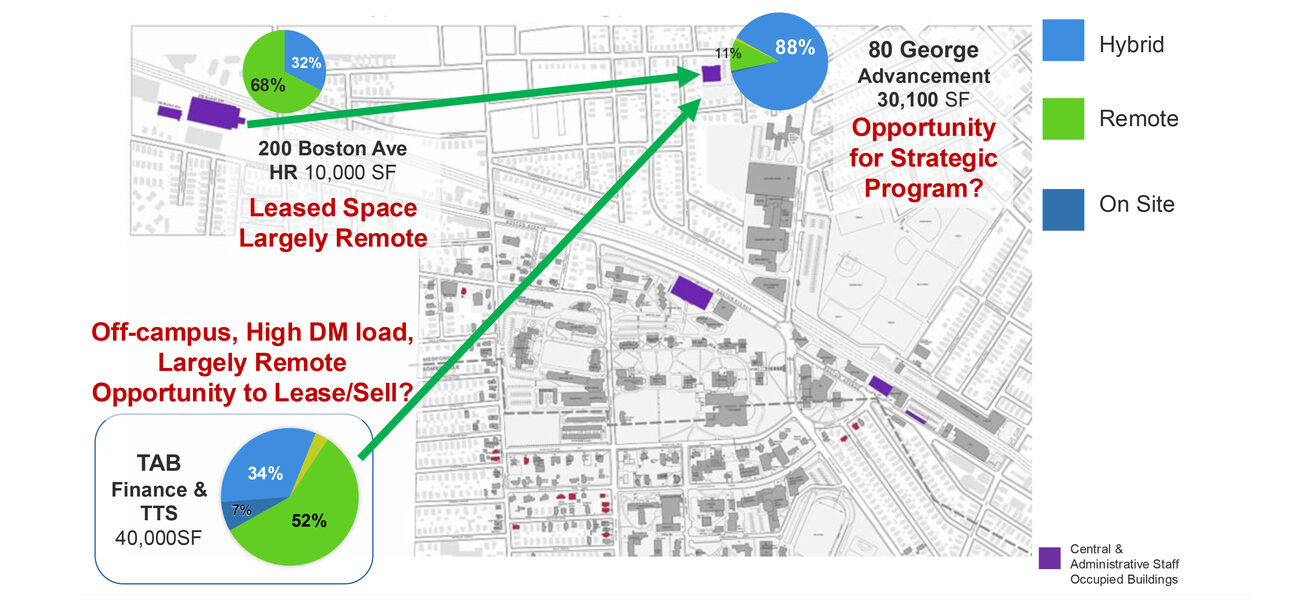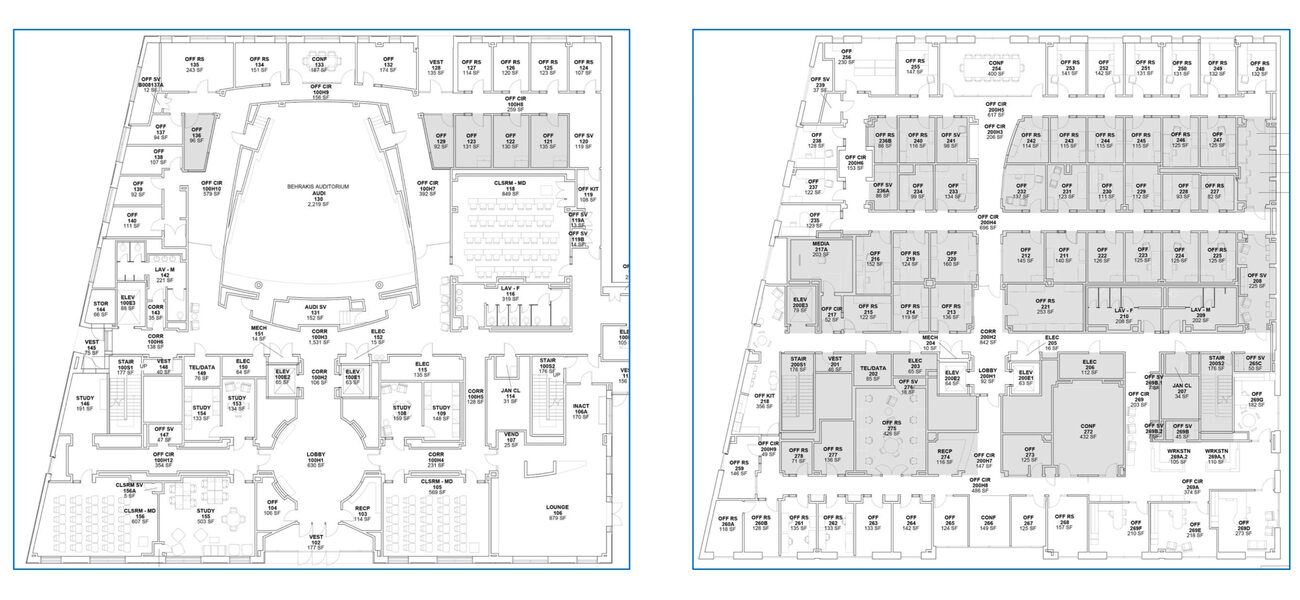Hybrid and remote work patterns that emerged under COVID guidelines seem to be here to stay, and universities are grappling with associated space utilization impacts alongside the cost pressures exerted by necessary program growth. In response, strategic space consolidation initiatives are paving the way for a more efficient and cost-effective approach to administrative space planning. Campus Planning at Tufts University was charged with aligning space usage with the evolving needs of faculty, staff, and students, leveraging data gleaned from utilization and occupancy at all four Tufts campuses, and have implemented space consolidations across the Medford/Somerville main campus as well as the Boston Health Sciences campus. Their takeaway: Consolidating office spaces in a way that better matches usage ensures that resources are allocated where they’re most needed.
A Changing Campus Landscape
Tufts University’s four campuses in the greater Boston area serve more than 5,000 staff and faculty and over 12,000 students. Historically, office space comprised 14% of the university’s total footprint, but with the shift to hybrid work models, many offices were underutilized. Recognizing this, Tufts launched an initiative to consolidate administrative space, maximize efficiency, and reduce costs. In 2022, Tufts’ campus planning team began a comprehensive data collection and analysis process.
Sara Cassidy Smith, AIA, LEED AP, senior campus planner, worked closely with human resource data collected around staff work schedules to calculate utilization and determine occupancy trends. The results were striking: On average, in 2022, administrative staff were using their office spaces at 37%—about two workdays a week. “We had staff schedules in days per week, and we had our space data,” says Smith. “We quickly realized that we also needed utilization data, which we didn’t initially have, but were able to calculate based on days per week spent on campus during fall 2022 in various facilities.”
To develop guidelines for office space assignments, Smith categorized employees into three groups based on their time in office: those on campus four to five days a week (who needed assigned space); those in two to three days (who could use reservable/shared spaces as needed); and those in less than two days (who could be allotted “touchdown” spaces).
Armed with data indicating that in certain locations, remote and hybrid workers were on site for less than 40% of their workdays, Smith’s team allocated space. “We took a tailored occupancy approach—a deep dive with each group,” says Smith. “For groups coming in for two days, we thought they would need 25 to 30 sf per person, on average. If we saw 40 to 60% utilization, we estimated 100 sf per person. And if groups were on site more than 60% of the time, we assumed an industry standard pre-COVID metric of 150 sf.”
The data showed the possibility of reducing administrative and staff spaces toward an upward limit of 50%.
Cost and Efficiency Gains: Where and How to Downsize
Buildings with high deferred maintenance needs and/or leased buildings located far from campus that predominantly house remote or hybrid workforces were considered prime candidates for downsizing or repurposing. At Tufts, this consideration included a hard look at properties at 80 George Street, 200 Boston Avenue, and the Tufts Administration Building (TAB), where employees associated with the university’s Finance, Human Resources, and Tufts Technology Services (TTS) departments were located.
In the summer of 2023, the university received an urgent space request from their host city of Somerville, which proved to be a fortunate coincidence that aligned with ongoing space planning efforts. With flex work data analysis in hand, Tufts was able to swiftly vacate 40,000 sf of the TAB building in Somerville, generating additional lease revenue and satisfying a need for the community.
During the first phase of space consolidations in the summer of 2023, employees with remote and infrequent hybrid schedules relocated to a centralized administrative hub at 80 George Street, freeing up space in TAB to lease and also vacating a suite in 200 Boston Avenue. In early February 2025, TAB’s remaining staff moved to a downsized footprint in 200 Boston Avenue with the intention of fully vacating the building by the end of the month, increasing the amount of space the university can lease to the city.
Through strategic consolidation, Tufts successfully reduced its administrative footprint by 28%—approximately 60,000 sf. While shy of the original 50% target, the initiative has yielded substantial financial benefits, saving the university $2.6 million annually in lease costs while generating new income from leased spaces.
“There is also a spinoff capital project to relocate two of the functions previously in TAB—a server room and a media studio where we record and produce on-line course content,” says Smith. “The estimated project cost to relocate the approximately 2,000 sf will be offset by lease income generated from TAB.”
Consolidation at Tufts’ Friedman School
As the Tufts Friedman School of Nutrition Science and Policy emerged from the pandemic, it grappled with underutilized office space and the costs associated with maintaining it. Out of its annual budget of approximately $38 million, the school was spending nearly $1.9 million for operations and maintenance, including a hefty $550,000 in lease costs alone.
Courtney King, the Friedman School’s director of business operations, saw an opportunity to bring the school’s community closer together while also cutting costs. The Friedman School is North America’s only graduate school of nutrition, offering master’s and doctoral programs to more than 160 students on Tufts’ Boston Health Sciences Campus. Faculty and staff had been split between two floors in a Tufts-owned building and a separate leased space around the corner, a short distance that nonetheless created a sense of separation before consolidation.
The Case for Consolidation
As the pandemic reshaped work habits, a large footprint became harder for campus planners to justify. Enrollment in graduate programs during that period also declined, tightening budgets at many institutions, including Friedman.
King saw a trend: “We were noticing that foot traffic was low, and not as many people were coming into the office. We started to think that there was an opportunity to consolidate, especially as we thought about the budget.” Those in the leased building around the corner already felt disconnected from their colleagues; the situation became more pronounced when hybrid work became the norm. Consolidation was not just a financial decision—it was necessary to enhance social cohesion within the institution.
Convincing leadership of the benefits of consolidation was the first hurdle. “The leased space had undergone costly renovations in prior years, so that made the university reluctant to abandon it,” says King. But when presented with the long-term savings of consolidation—an estimated $700,000 per year—the decision became easier. “Once leadership was on board, the next challenge was winning over faculty, staff, and students,” says King. The message was clear: This move was about revitalizing the school’s culture.
“We made the decision; we’re going to consolidate,” says King. “The messaging was really important: If you’re not coming in every day of the week, on the days that you are in, you’ll be able to interact with your colleagues.”
With the help of Tufts’ campus planning team, the transition was meticulously orchestrated. A move manager was hired to ensure a seamless relocation onto campus, and regular updates kept stakeholders informed. “We’re still looking at post-occupancy studies, but our new footprint on the Boston campus is consolidated to two floors,” says King. “We’re making a concerted effort to keep all partners up to date. But we’re already on target to achieve the $700,000 per year estimate.”
“My Office” versus “Our Offices”
It takes careful messaging to help staff adjust to new realities. A common grievance arises when a high-stature, newly hired faculty member occupies a prime, windowed office despite only coming into the office a few days per week, while staff whose work requires daily on-site presence are relegated to less “prime” spaces. But with fewer staff coming into the office on a 9-to-5, Monday-Friday basis, many schools are revising their policies: Those who use the space most get priority, regardless of title.
“We recently had two faculty members agree to share a windowed office,” says King. “It’s about approaching people, having conversations, and identifying who is open to this setup.” With an increasing number of faculty hires in the pipeline at institutions like Tufts, such compromises will only become more common. “We’re actively addressing these disparities in our upcoming space policy updates,” says King. “But it’s an ongoing conversation—we are still learning as we go.”
By Liz Batchelder



